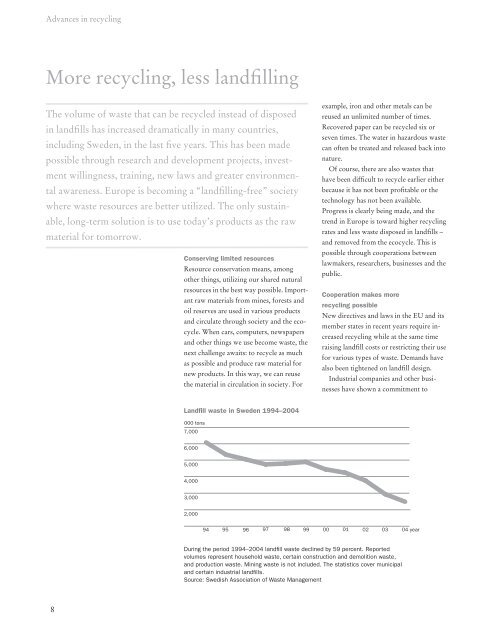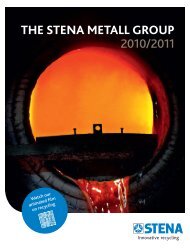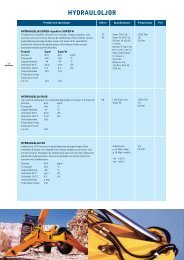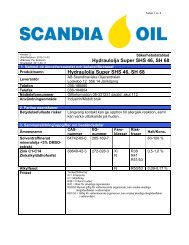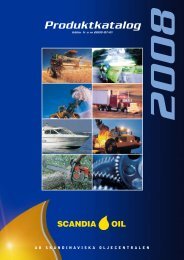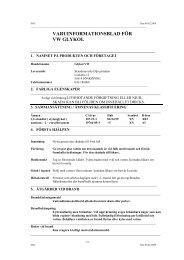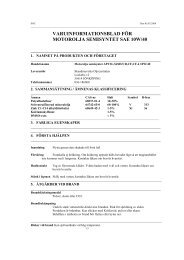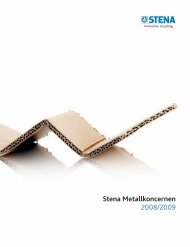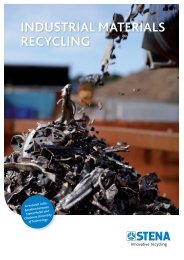STENA METALL AB - Stena Metall Group
STENA METALL AB - Stena Metall Group
STENA METALL AB - Stena Metall Group
Create successful ePaper yourself
Turn your PDF publications into a flip-book with our unique Google optimized e-Paper software.
Advances in recycling<br />
More recycling, less landfilling<br />
The volume of waste that can be recycled instead of disposed<br />
in landfills has increased dramatically in many countries,<br />
including Sweden, in the last five years. This has been made<br />
possible through research and development projects, investment<br />
willingness, training, new laws and greater environmental<br />
awareness. Europe is becoming a “landfilling-free” society<br />
where waste resources are better utilized. The only sustainable,<br />
long-term solution is to use today’s products as the raw<br />
material for tomorrow.<br />
Conserving limited resources<br />
Resource conservation means, among<br />
other things, utilizing our shared natural<br />
resources in the best way possible. Important<br />
raw materials from mines, forests and<br />
oil reserves are used in various products<br />
and circulate through society and the ecocycle.<br />
When cars, computers, newspapers<br />
and other things we use become waste, the<br />
next challenge awaits: to recycle as much<br />
as possible and produce raw material for<br />
new products. In this way, we can reuse<br />
the material in circulation in society. For<br />
example, iron and other metals can be<br />
reused an unlimited number of times.<br />
Recovered paper can be recycled six or<br />
seven times. The water in hazardous waste<br />
can often be treated and released back into<br />
nature.<br />
Of course, there are also wastes that<br />
have been difficult to recycle earlier either<br />
because it has not been profitable or the<br />
technology has not been available.<br />
Progress is clearly being made, and the<br />
trend in Europe is toward higher recycling<br />
rates and less waste disposed in landfills –<br />
and removed from the ecocycle. This is<br />
possible through cooperations between<br />
lawmakers, researchers, businesses and the<br />
public.<br />
Cooperation makes more<br />
recycling possible<br />
New directives and laws in the EU and its<br />
member states in recent years require increased<br />
recycling while at the same time<br />
raising landfill costs or restricting their use<br />
for various types of waste. Demands have<br />
also been tightened on landfill design.<br />
Industrial companies and other businesses<br />
have shown a commitment to<br />
Landfill waste in Sweden 1994–2004<br />
000 tons<br />
7,000<br />
6,000<br />
5,000<br />
4,000<br />
3,000<br />
2,000<br />
94 95 96 97 98 99 00 01 02 03 04 year<br />
During the period 1994–2004 landfill waste declined by 59 percent. Reported<br />
volumes represent household waste, certain construction and demolition waste,<br />
and production waste. Mining waste is not included. The statistics cover municipal<br />
and certain industrial landfi lls.<br />
Source: Swedish Association of Waste Management<br />
8


